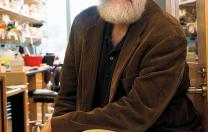This July, Wyss Institute fellow Kevin Esvelt and Winthrop professor of genetics George Church coauthored a paper in the journal eLife outlining how new technologies containing self-replicating pieces of DNA could potentially be used to genetically reengineer entire species in the wild. A recently discovered bacterial system called CRISPR-Cas, named after the DNA and proteins involved, has allowed scientists to make highly specific genetic modifications with greater ease than ever before (see harvardmag.com/genomic-14). As Church and colleagues predicted in the recent paper, certain genetic changes that themselves include a CRISPR-Cas system could copy themselves in a process called a “gene drive,” enabling a modification to spread through an entire species during the course of many generations. Scientists might one day be able to alter or even eliminate entire species—reengineering herbicide susceptibility into populations of resistant weeds, for instance, or suppressing malaria mosquitoes or invasive plants.
Church’s technical paper was published simultaneously with a policy paper in Science that assessed the technology’s possible impacts. The environmental and security effects of gene drives are still unclear, wrote the authors, a team of scientific and legal experts that included technologists Church and Esvelt, Ph.D. ’10, evolutionary ecologist and former National Science Foundation director for population biology and physiological ecology James P. Collins, and lead author Kenneth Oye, Ph.D. ’83, professor of political science at MIT. Moreover, regulatory gaps remain: domestic and international policies, built narrowly around lists of dangerous toxins or organisms, fail to address the uniquely broad character of gene drives. The authors made 10 recommendations for managing environmental and biosecurity risks. Certain types of gene drives might reverse prior genetic changes or immunize organisms from further modification, for instance, and new regulatory structures might adopt broader definitions of biological impact. The authors also called for a public discussion on how the new technology ought to be used. “For emerging technologies that affect the global commons, concepts and applications should be published in advance of construction, testing, and release,” they wrote in conclusion. “Lead time will allow for broadly inclusive and well-informed public discussion to determine if, when, and how gene drives should be used.”









